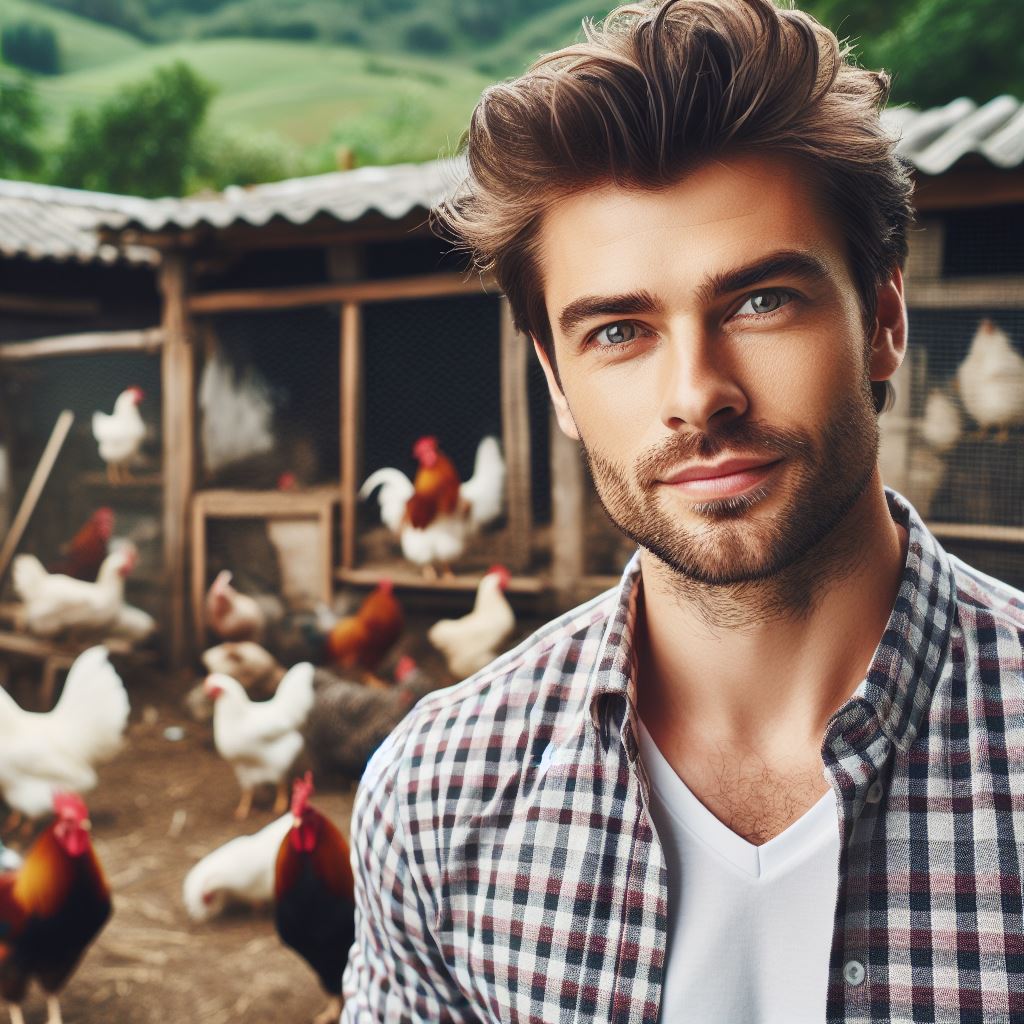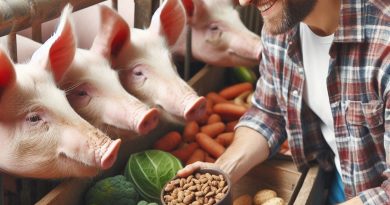Poultry Farming: Dealing with Predators
Last Updated on January 23, 2024
Introduction
Poultry farming is a vital industry, and addressing predator issues is crucial for its success.
Predators can have a devastating impact on poultry, resulting in loss of livestock, decreased production, and financial losses for farmers.
It is essential to understand the importance of dealing with predators effectively.
Importance of addressing predator issues in poultry farming
Predators pose an acute threat to the well-being and growth of poultry.
They can cause direct harm by attacking and killing birds, resulting in a decrease in the overall population and the subsequent decline in egg-laying capacity.
This loss of livestock can incur sizable financial losses for poultry farmers.
Moreover, the fear of predators can lead to stress among poultry, affecting their growth and overall health. Poultry may not consume enough food or water due to constant fear, resulting in reduced productivity. The overall quality of eggs and meat can also suffer due to elevated stress levels.
Overview of the impact of predators on poultry farming
Predator attacks can disrupt the entire farming system, causing unnecessary stress and efforts for farmers.
It is essential for farmers to be aware of the risks and seek proactive measures to prevent and manage predator issues.
These measures can include building secure enclosures, installing proper lighting and fencing, and using deterrents like noise or motion-activated devices.
In summary, addressing predator issues is of utmost importance in poultry farming.
Understanding the impact of predators on poultry is crucial to implement effective prevention and management strategies.
By safeguarding their flocks, farmers can ensure the well-being and success of their poultry farming operations.
Common Predators in Poultry Farming
When it comes to poultry farming, one of the biggest challenges that farmers face is dealing with predators.
These predators pose a significant threat to the safety and well-being of the poultry, as well as the farmer’s livelihood.
In this section, we will discuss common predators such as foxes, raccoons, snakes, and birds of prey, explaining their hunting habits and patterns.
Foxes
Foxes are cunning and agile predators that can cause havoc on poultry farms.
They are known for their ability to dig under fences and sneak into coops.
Foxes primarily hunt during the night, making their presence difficult to detect.
They often target chickens, ducks, and small birds, causing serious damage to the flock.
Farmers need to reinforce their coop’s security measures and install sturdy fences to keep foxes at bay.
Raccoons
Raccoons, with their nimble paws and sharp teeth, are another notorious predator in poultry farming.
They are excellent climbers and can easily scale fences and trees to gain access to the coop.
Raccoons have a knack for finding weak spots in a coop’s structure, and once they infiltrate, they show no mercy to the poultry.
They are nocturnal creatures, so it’s crucial for farmers to ensure the coop is properly secured before nightfall.
Snakes
Snakes pose a different kind of threat to poultry.
They are stealthy predators that can surprise both the poultry and the farmer.
Snakes are skilled at slithering their way into coops, often through small gaps or holes.
Once inside, they have a wide variety of poultry to choose from.
Their hunting patterns are not limited to day or night, making it challenging for farmers to predict and prevent attacks.
A thorough inspection of the coop to identify and seal potential entry points is essential to keep snakes at bay.
Birds of Prey
Birds of prey, such as hawks and owls, are natural hunters that pose a significant threat to vulnerable poultry.
These aerial predators have excellent vision and swoop down from above to snatch their prey.
Free-ranging chickens and ducks are especially vulnerable to bird attacks.
Farmers can employ a mix of deterrents like shiny objects and scarecrows to keep birds of prey away from their poultry.
Building an enclosed run can also provide protection from aerial attacks.
Hunting habits and patterns
It is important for poultry farmers to be aware of these common predators and their hunting habits.
Understanding their tendencies can help farmers implement effective preventive measures and safeguard their precious flock.
Combinations of physical barriers, like strong fences, secure coops, and enclosed runs, along with deterrents, can significantly reduce predation risks.
Additionally, maintaining a vigilant eye and conducting regular checks for signs of predator activity are essential to promptly address any breaches in the farm’s security.
By being proactive and implementing sound predator management strategies, poultry farmers can minimize losses and ensure the safety and well-being of their flock.
Being aware of the local predator population, seeking advice from experienced farmers or agricultural extension services, and staying up-to-date with relevant research and innovations can further assist in developing effective predator control plans.
Remember, protecting poultry from predators is an ongoing battle that requires constant vigilance and adaptation to changing circumstances.
Read: Optimal Nutrition for Chickens & Turkeys
Identifying Signs of Predator Activity
In order to effectively deal with predators on a poultry farm, it is crucial for farmers to be able to identify signs of their presence.
By being aware of these signs, farmers can take the necessary measures to protect their flocks and minimize potential losses.
Here are some key points to consider:
How to recognize signs of predator presence
Tracks
Inspect the farm surroundings for footprints and other signs of animal activity.
Predators often leave tracks behind, which can help identify the potential threat.
Droppings
Raccoon feces can be identified by its cylindrical shape and pointy ends.
Learning to distinguish between different droppings can assist in determining the predator responsible.
Damage
Inspect the farm for any signs of damage caused by predators.
This may include torn fences, chewed wires, or scratched surfaces.
Such damage indicates that predators have been attempting to gain access to the poultry.
Importance of regular monitoring and inspections
Regular monitoring and inspections play a vital role in identifying signs of predator activity.
By closely observing their environment, farmers can quickly detect any potential threats and take appropriate action.
Here are further details:
Inspections
Conduct thorough inspections of their farm each day.
Pay attention to areas where predators are most likely to sneak in, such as around coops, feed storage areas, and water sources.
Early detection
Early detection of predator activity can prevent significant damage and potential loss of their flock.
By proactively monitoring their farm, farmers can implement preventative measures promptly.
Response to signs
Respond when signs of predator activity are observed.
This may include setting up traps, installing deterrents, or increasing security measures such as lighting and fencing.
To effectively address the issue of predator activity, farmers must be vigilant in recognizing signs and taking appropriate measures.
By imparting knowledge about signs of presence and the importance of regular monitoring, farmers can protect their poultry from predators and ensure the success of their poultry farming venture.
Read: Innovative Poultry Housing Solutions in 2024
Preventive Measures
Fencing and Enclosures
Poultry farmers can implement various measures to prevent predators from accessing their farms and causing harm to their poultry.
One of the most effective preventive measures is the use of appropriate fencing and enclosures.
Types of fences suitable for poultry farming
The chosen fence should be tall and sturdy, ideally made of chain link or wire mesh, with small gaps to prevent predators from squeezing through.
Barbed wire can also be added on top for extra security.
Proper installation techniques
The fence should be buried at least a foot underground to deter predators from digging underneath.
It should also be securely anchored to prevent any weak points that can be exploited.
Use of electric fences for added protection
Electric fences can offer an additional layer of protection as shock deterrents for predators.
These fences should be properly installed and regularly maintained to ensure their effectiveness.
Secure Coops and Housing
Properly securing coops and housing is essential in preventing predators from gaining access to the poultry.
Reinforcing coop structures
Coops should be built with strong materials such as metal or heavy-duty wood to withstand predator attacks.
Regular maintenance and inspection are necessary to ensure that the coop remains predator-proof.
Use of sturdy materials
Choosing strong and durable materials for coop construction will make it harder for predators to break into the poultry housing and harm the birds.
Closing all openings and vents
All openings, windows, and vents must be securely closed during the night to prevent predators from entering the coop.
Regular checks should be conducted to ensure there are no gaps or holes.
Predator Deterrents
Predator deterrents can be utilized as effective tools in deterring potential threats from approaching the poultry farm.
Motion-activated lights and sirens
Installing motion-activated lights and sirens can startle predators, making them reluctant to approach the poultry farm.
These devices should be strategically placed in vulnerable areas.
Scarecrows or scare tactics
Scarecrows, flags, or reflective materials can be used to create a visual deterrent that frightens predators and discourages them from approaching the poultry farm.
Scent deterrents like coyote urine
Applying scents that predators associate with danger, such as coyote urine, can deter them from coming near the poultry farms.
These scents should be regularly refreshed to maintain their effectiveness.
Securing Poultry during Outdoor Activities
In order to protect your poultry from predators during outdoor activities, there are a number of effective strategies you can implement.
Implementing controlled grazing and foraging practices
- Rotate your poultry’s outdoor grazing areas regularly to prevent predators from learning their patterns.
- Create a secure perimeter around the grazing areas using sturdy fences.
- Remove any tall grass or bushes near the grazing areas that may provide hiding spots for predators.
- Trim the wings of your poultry to limit their ability to fly over fences and escape from predators.
Utilizing portable electric netting for temporary enclosures
- Set up portable electric netting around your poultry’s outdoor area to provide an added layer of protection.
- Ensure that the netting is properly grounded and electrified to deter predators from approaching.
- Regularly check the netting for any damages or loose connections that may compromise its effectiveness.
- Move the netting to different areas periodically to prevent predators from finding weak spots.
Constant supervision during outdoor activities
- Never leave your poultry unattended during outdoor activities, especially during periods of high predator activity.
- Assign a responsible person to watch over the poultry and be prepared to respond to any predator threats.
- Use scare tactics such as motion-activated lights or noise-making devices to deter predators from approaching.
- If possible, provide a secure shelter or coop within the outdoor area where your poultry can seek refuge if threatened.
By implementing these strategies, you can greatly minimize the risk of predator attacks and ensure the safety of your poultry during outdoor activities.
Read: Poultry Health: Preventing Common Diseases

Protection Measures during Nighttime
In order to protect your poultry from nocturnal predators, it is important to implement several key protection measures.
These measures include:
Efficient lighting around the coop and run to discourage nocturnal predators
- Install bright lights around the perimeter of the coop and run to create a well-lit environment.
- Choose lights with motion sensors to deter predators by startling them with sudden bursts of light.
- Regularly check that the lights are functioning properly and replace any burnt-out bulbs immediately.
Securely locking birds inside the coop during the night
- Ensure that the coop is constructed with strong and secure doors that cannot be easily opened by predators.
- Install sturdy locks, latches, or padlocks on all coop entrances to prevent unauthorized access.
- Regularly inspect the coop for any gaps or holes that predators could exploit and promptly repair them.
- Establish a strict daily routine of locking the birds inside the coop at dusk and releasing them at dawn.
Using predator-resistant roosts and nesting areas
- Construct roosts and nesting areas that are difficult for predators to access.
- Elevate the roosts and nesting areas off the ground, utilizing sturdy poles or beams and hardware cloth.
- Position the roosts and nesting areas away from nearby trees or structures that could provide access to predators.
- Regularly inspect the roosts and nesting areas for signs of damage or weakness and reinforce them as needed.
By implementing these protection measures, you can significantly reduce the risk of nocturnal predators harming your poultry.
Remember to remain vigilant and regularly evaluate the effectiveness of these measures to ensure the safety and well-being of your birds.
Read: Starting a Poultry Farm: Essential Steps & Tips
Predator Trapping and Removal
Poultry farming can be severely impacted by predators, such as foxes, raccoons, coyotes, and rats, which pose a threat to both the birds and the farm’s profitability.
To protect your poultry from these predators, trapping and removal methods can be effective solutions.
Methods for trapping and relocating predators
- Live traps: These can be highly effective in capturing small to medium-sized predators without causing them harm.
- Cage traps: Similar to live traps, cage traps enable capture without injury, allowing for easy relocation.
- Foot snares: These are designed to safely catch and restrain predators until they can be relocated.
- Funnels and one-way doors: These devices allow predators to exit the poultry area but prevent re-entry.
After trapping predators, it is essential to relocate them to a suitable habitat far away from your farm.
This ensures they won’t return to threaten your poultry again.
Importance of following local regulations and seeking professional assistance, if necessary
When dealing with predator trapping and removal, it is crucial to comply with local regulations and laws.
These regulations vary from region to region, so it is essential to do thorough research and understand the legal requirements.
If you are unsure about the regulations or lack the necessary trapping expertise, seeking professional assistance is highly recommended.
Professionals have the knowledge and experience to ensure effective trapping while safeguarding the well-being of both the predators and your poultry.
Benefits of predator trapping and removal
Implementing predator trapping and removal practices offers several advantages for poultry farmers:
- Poultry safety: Trapping and removing predators significantly reduce the risk of attacks on your birds, increasing their safety and overall survival rate.
- Financial protection: By safeguarding your poultry from predators, you are protecting your investment and ensuring continued profitability.
- Peace of mind: Knowing that you have effectively minimized the threat of predators allows you to manage your farm with less stress and worry.
Additional measures to deter predators
In addition to trapping and removing predators, there are other preventive strategies poultry farmers can employ:
- Fencing: Secure your poultry area with sturdy fencing, buried at least several inches deep to discourage burrowing predators.
- Lighting: Install motion-activated lights around the perimeter of your poultry farm to deter nocturnal predators.
- Guard animals: Consider using guardian animals, such as dogs or llamas, to protect your poultry from potential threats.
- Secure housing: Ensure that your poultry housing is properly built, with no gaps or holes that predators can exploit.
Remember, a comprehensive approach that combines trapping and removal techniques with preventive measures is the key to effective predator management in poultry farming.
By actively addressing this issue, you can promote a secure and productive environment for your birds.
Responding to Predator Attacks
Steps to Take When a Predator Attack Occurs
- Assess the situation immediately to determine the type of predator and the extent of damage.
- Secure the remaining poultry by placing them in a safe and enclosed area.
- Call for assistance if needed, such as contacting local animal control or a professional pest control service.
- Document the attack by taking photographs of the affected area and any evident signs of the predator.
- Clean and disinfect the attacked area to prevent the spread of diseases and to remove any attracting smells.
Proper Disposal of Deceased Poultry and Disinfection Protocols
- Separate any dead poultry from the live ones and dispose of them properly.
- Bury the carcasses deep in the ground to prevent scavengers from being attracted to the area.
- Wear protective gloves and use disinfectants to clean surfaces where the predator attack occurred.
- Properly dispose of the cleaning materials used to prevent cross-contamination.
- Follow recommended disinfection protocols to eliminate any pathogens or parasites left behind.
Evaluating the Effectiveness of Preventive Measures and Making Necessary Adjustments
- Review the effectiveness of the existing preventive measures in deterring predator attacks.
- Analyze the vulnerabilities of the poultry farm and identify areas that need improvement.
- Consider implementing additional defensive measures like installing motion-activated lights or electric fences.
- Seek advice from experts or experienced poultry farmers to gain insights and suggestions for better protection.
- Continuously monitor the farm for any signs of predatory activity and make necessary adjustments accordingly.
Swift and efficient response to predator attacks is vital for safeguarding poultry farming operations.
A prompt assessment enables immediate action to secure remaining poultry and prevent further losses.
Seeking professional help from animal or pest control services adds expertise to managing the situation.
Photographic documentation aids in predator identification and assessing the farm’s impact, useful for insurance claims and legal purposes.
Thoroughly cleaning and disinfecting the affected area prevents disease spread and removes attractants for potential repeat attacks.
Proper disposal of deceased poultry prevents scavenger attraction, with burial recommended for contamination control.
Disinfecting the attack site and adhering to cleaning protocols maintain a healthy environment.
Regular evaluation of preventive measures and identifying vulnerabilities are essential for farm security.
Seeking advice from experts and farmers enhances protection.
Continuous vigilance detects predatory signs early, allowing adjustments to reduce future risks.
Implementing preventive measures and adapting strategies ensures poultry farm safety and flock well-being.
Conclusion
Recap the key points discussed in the blog post
Overall, this blog post discussed the key points related to poultry farming and dealing with predators.
It emphasized the importance of proactive predator management for successful poultry farming.
Throughout this blog post, we explored various measures that can be taken to protect poultry from predators.
We discussed the significance of securing the farm with proper fencing and using deterrents such as noise and light.
The importance of proactive predator management for successful poultry farming
Additionally, we highlighted the importance of monitoring the farm regularly and implementing measures like trapping and removing predators to minimize the risk of attacks.
By being proactive, farmers can significantly reduce losses due to predators.
Furthermore, we touched upon the significance of evaluating the specific predators in the area and implementing appropriate measures to deter them effectively.
This could include using guard animals or employing electric fencing.
Overall, effective predator management is essential for maintaining the safety and well-being of poultry.
By implementing the strategies discussed in this blog post, poultry farmers can mitigate the risk of predation and ensure the success of their operations.
In closing, poultry farmers should prioritize proactive predator management to protect their valuable birds and operations.
Taking the necessary precautions and using preventive measures can help farmers avoid potential losses and maintain a thriving poultry farming business.


